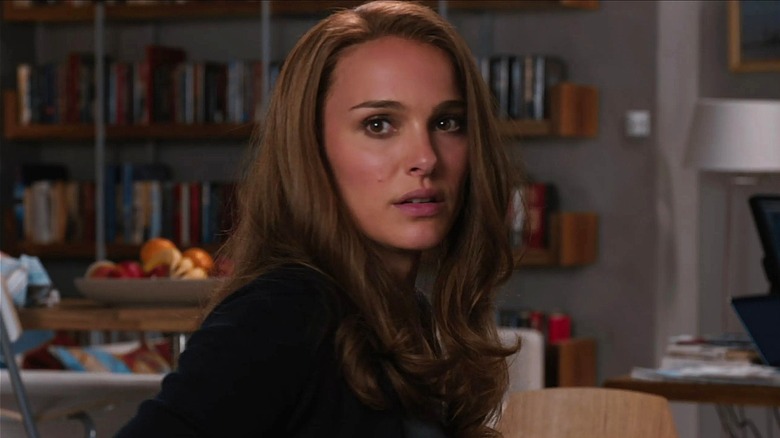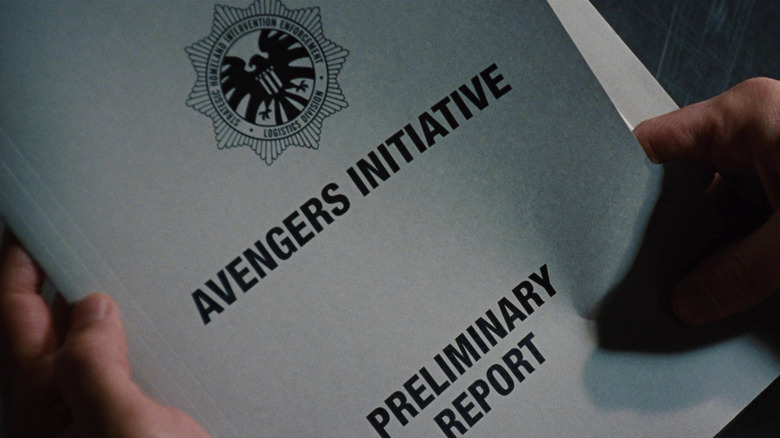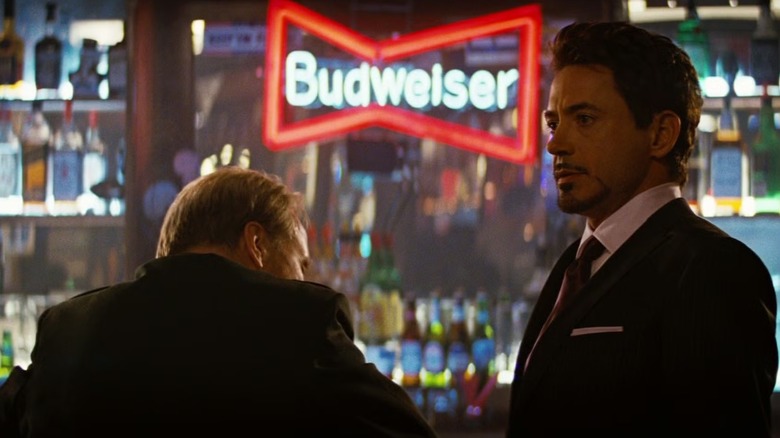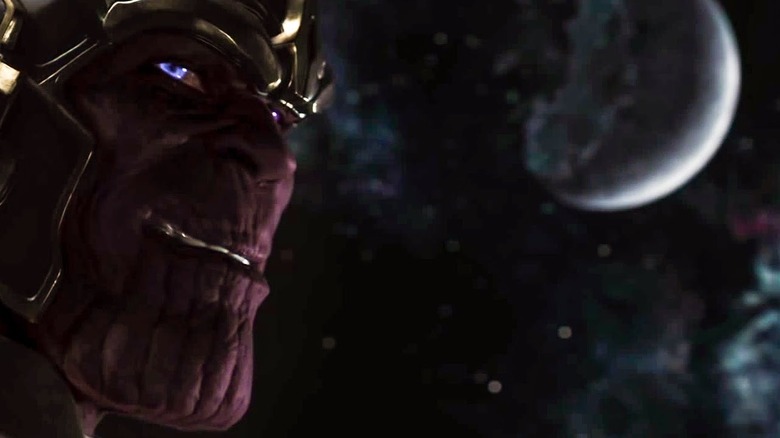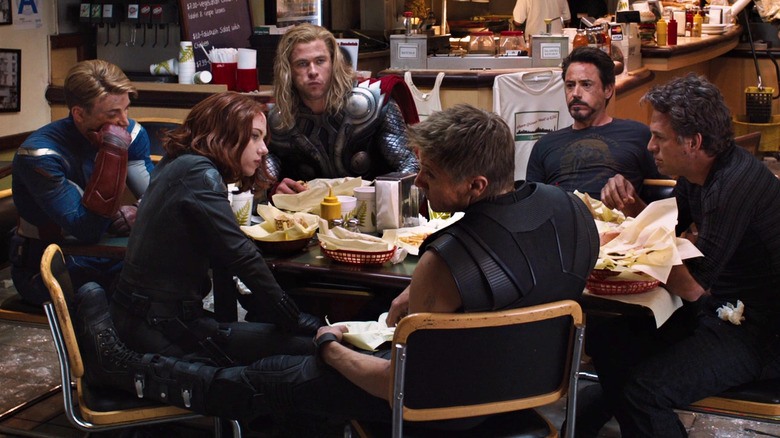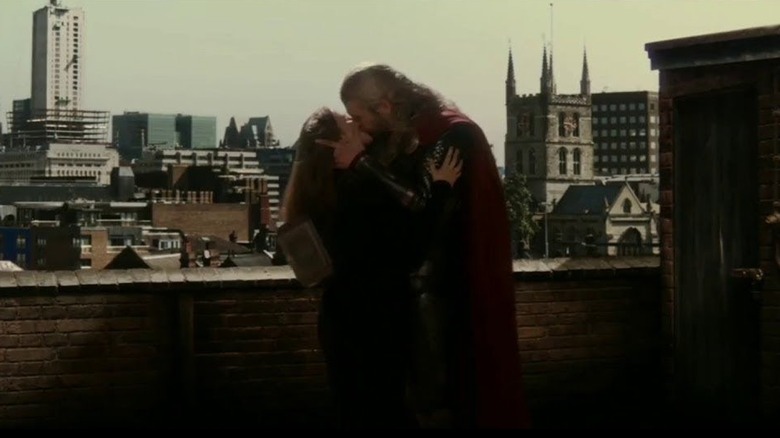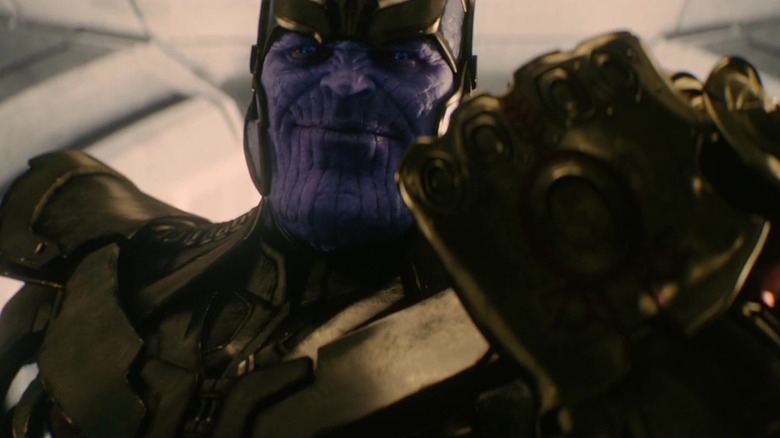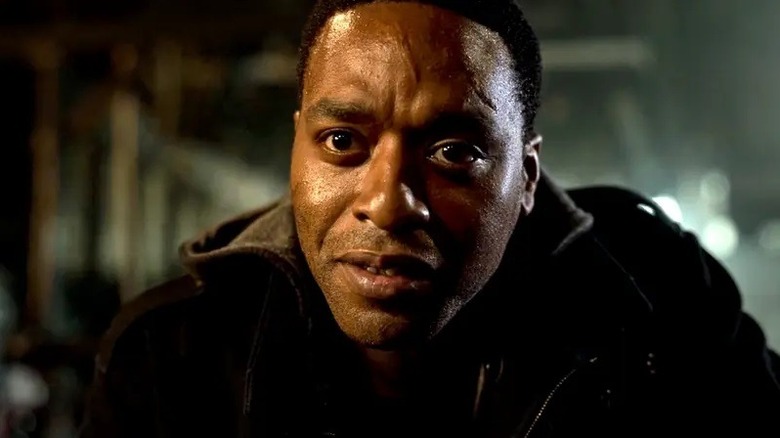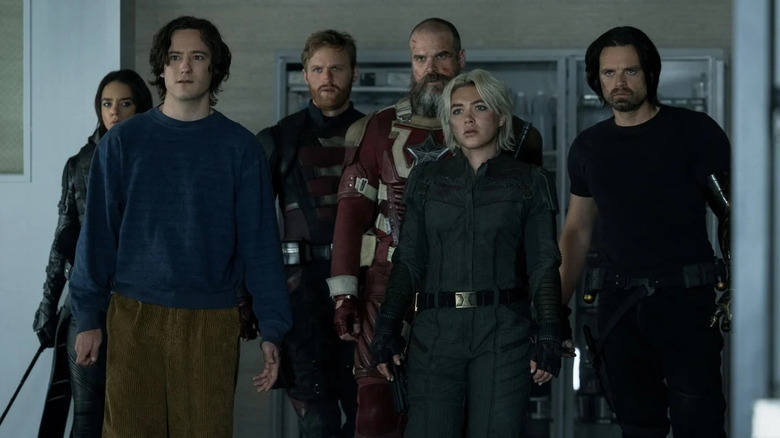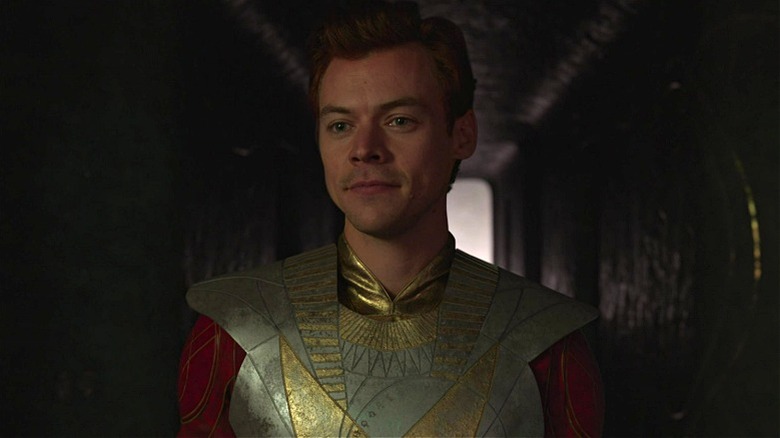We Rewatched All The MCU Post-Credit Scenes And They're Completely Different Now
The year is 2008. Millions of people head to the theater over the summer to check out "Iron Man," and, even though the superhero cinema landscape will soon get swallowed up by "The Dark Knight," there's one thing people can't stop talking about. When the credits started rolling, plenty of folks got out of their seats right away because why wouldn't they? The movie's over. But for those patient enough to wait (or those who just wanted to hang out and talk to their friends for a bit), they would see the beginning of a legacy. They would witness an extra scene at the end of the movie where Nick Fury (Samuel L. Jackson) talks to Tony Stark (Robert Downey Jr.) about the Avengers Initiative, and nothing would ever be the same again.
Even though "Iron Man" was far from the first film to incorporate a post-credits scene, it would set the tone for every other film in the Marvel Cinematic Universe. Today, no one can get out of their seat before the credits are done without worrying about whether or not they missed a crucial bit of world-building. You never know what character might get introduced next or what funny joke might arise that everyone will quote later. Marvel post-credits scenes may be small portions of the movie, but they leave a major impact. And when you go back and rewatch all of the MCU, you'll notice certain things that make them odd or far more fascinating in hindsight.
Iron Man - Why did the Avengers Initiative take so long?
The "Iron Man" post-credits scene is the stuff of legend by now, and Nick Fury almost didn't say anything about the Avengers Initiative. Several different lines were recorded, but in the end, they chose to tease a superhero team-up film, with the implication that Fury had been working on this for a while. In fact, he'd been working on it since 1995 after the events of "Captain Marvel" took place, when he first drafted his proposal. "Captain Marvel" confirmed this, and it does beg the question as to why it took Fury so long to get off his butt and wrangle up some superheroes.
Carol Danvers (Brie Larson) went off-world, but she could've been called under the right circumstances. Hank Pym (Michael Douglas) was also around, though may have been too depressed following Janet van Dyne (Michelle Pfeiffer) going missing to engage in any heroics. It seems that Fury just happened to get very lucky that a group of superheroes made themselves known right before an alien army invaded New York City.
There is another explanation for why Fury sat on this plan for so long, but it has its own problems. In 2012's "The Avengers," Fury mentions how S.H.I.E.L.D. intended to use the Tesseract to build an arsenal to protect the planet, but he clarifies, "I never put all my chips on that number, though," before saying how he wanted to assemble a team of superpowered individuals, calling it "riskier." Why would getting a group of heroes together be "riskier" than toying with alien technology? Sure, the Avengers don't work well together at first, but it seems like the route he should've taken from the get-go rather than messing around with glowing cubes.
The Incredible Hulk - Why is Tony Stark working for S.H.I.E.L.D.?
The plan of an interconnected cinematic universe became clearer later in 2008 with "The Incredible Hulk." That post-credits scene sees the return of Tony Stark, this time visiting General Thaddeus "Thunderbolt" Ross (William Hurt) in a bar to discuss plans of putting together a team. For anyone blown away by "Iron Man," it was neat to see Stark again so soon, but the scene doesn't make a ton of sense upon rewatch. Why is Stark the one sent to talk with Ross rather than someone who actually works for S.H.I.E.L.D.? Why is he even talking to Ross in the first place, since Bruce Banner, aka the Hulk (Edward Norton, later Mark Ruffalo), is on the run?
The post-credits scene in "The Incredible Hulk" seems so hastily put together because it kind of was. Director Louis Leterrier told Collider that they only had five hours to shoot something with Robert Downey Jr., saying, "They had like ½ a day where they could give us ½ a day, so I just directed [the] 'Iron Man' crew for one day." It clearly couldn't be anything too extensive, and any lingering questions were eventually answered by the 2011 Marvel One-Shot "The Consultant."
This short film sees Phil Coulson (Clark Gregg) meet with Jasper Sitwell (Maximiliano Hernández) about how the World Security Council wants the Abomination (Tim Roth) for the Avengers after the Hulk is blamed for Harlem's destruction at the end of "The Incredible Hulk." Fury doesn't want that, so they intentionally sabotage the assignment by sending Stark to annoy Ross so that he won't cooperate. It's a clever retcon to explain Stark's role and how they were talking about Abomination all along.
The Avengers - Death gets mentioned
The build-up that began with the "Iron Man" post-credits scene paid off with 2012's "The Avengers." The world got to see Iron Man, Thor (Chris Hemsworth), and Captain America (Chris Evans) team up on the big screen, paying off years of teases. What no one knew going into the film was that "The Avengers" was really just the beginning. It's a big universe out there, and one of the post-credits scenes for that film sees the introduction of Thanos (Damion Poitier, later Josh Brolin). The Other informs Thanos that "To challenge [humans] is to court death," and Thanos' only response is to turn and smirk.
This is a nod to Thanos' desire to make the personification of Death fall in love with him, one of the many things about Thanos that didn't make it into the MCU. The reason he wants to wipe out half of the universe is to impress Death with all of the, well, death. Apparently, those involved in the MCU thought this was too abstract of a concept or simply wouldn't play well with general audiences. Instead, the franchise gave Thanos a more comprehensible justification for snapping away half of existence: He wants to ensure there are enough resources to go around.
Naturally, Joss Whedon wouldn't have known this when penning the screenplay for "The Avengers," so he leaned on the intergalactic warlord's more nebulous comic book motivations. Death would eventually be introduced in the MCU, portrayed by Aubrey Plaza in "Agatha All Along." Of course, this came way too late to be linked back to the Mad Titan: He had already been defeated by Tony Stark, who gave Thanos a taste of his own medicine by blipping him and his army out of existence.
The Avengers - The shawarma scene was filmed after the premiere
"The Avengers" has two stellar moments once the movie ends that exemplify the typical Marvel post-credits scene — one that sets up future plot points, and one that's just plain funny. Once the credits are done for good, audiences get to see an extra scene where the Avengers are enjoying a well-earned shawarma meal, following up Tony Stark's joke that they should go out for shawarma earlier in the film. It's a hilarious moment that audiences could only catch after the film's premiere.
That's because the team actually shot the post-credits scene two days after the premiere, as it entailed getting all six actors together to sit around the table for a minute. It's a solid addition, as it shows the Avengers as a fully-fledged team. Plus, who hasn't sat awkwardly in silence while grabbing a bite to eat with co-workers? Director Joss Whedon later admitted the idea of the scene came to him after filming a dramatic death scene for "Angel," and when he and the show's actors went to get a drink after, they all just sat in silence.
The Avengers all look exhausted but none more so than Captain America, who can barely keep his head up, propping it against his fist. We later learned why Steve Rogers looks so solemn in the shawarma scene: It was down to Chris Evans having a beard at that point for "Snowpiercer." Since the scene was shot way after everything else, Evans looked vastly different at the time. They applied makeup to cover the beard somewhat, but they needed his hand to cover the rest. Now that you know this, you won't be able to take your eyes off Cap in this post-credits scene.
Thor: The Dark World - The emotional story ends in the post-credits scene
Post-credits scenes, in Marvel movies or otherwise, typically set up a sequel or provide a quick laugh. Ideally, the film's story and themes have been wrapped up, so the extra scene can just provide a simple bonus. But when you rewatch "Thor: The Dark World," you may realize the story's emotional core isn't resolved fully until after the credits are done.
The extra scene shows Jane Foster (Natalie Portman) depressed on Earth until Thor shows up, and the two embrace and kiss. This follows Thor abdicating the throne of Asgard, and it looks like he's going to just hang out on Earth with his girlfriend instead. It establishes that Thor's on Earth by the time "Avengers: Age of Ultron" comes around, but it feels like a scene that should've come at the very end of the film itself, before the credits show up.
The story doesn't come full circle until we get that moment of seeing Thor and Jane together, leaving us safe in the knowledge that they are going to try to make things work on Earth. It represents an evolution of the Marvel post-credits scene in that you have to stick around until the credits finish in case a major plot point gets resolved. Watching it back now, you realize just how vital this post-credits scene is to the entire MCU timeline.
Avengers: Age of Ultron - Who is Thanos talking to?
Despite getting introduced in "The Avengers" in 2012, Thanos wasn't quite ready for the big time when "Avengers: Age of Ultron" came out in 2015. But the franchise still wanted to build hype around the big purple guy, so the post-credits scene consists of Thanos retrieving the Infinity Gauntlet from a secure safe before saying, "Fine, I'll do it myself." The scene clearly exists to tee up Thanos for "Avengers: Infinity War," but it also raises some questions. For starters, who is Thanos talking to? No one else appears to be in the room with him.
The answer to this is obviously that he's talking to the audience, letting us know that he's getting ready to join the fight himself. The fact that this post-credits scene takes place after "Avengers: Age of Ultron" has been a source of confusion for some fans. When he says he'll do it himself, is he talking about taking down the Avengers, something Ultron cannot do? Later films confirm that he's actually talking about collecting the Infinity Stones here, having grown fed up following the failure of Loki and Ronan the Accuser.
The thing is, Thanos takes his sweet time getting to Earth if we're to assume these "Avengers" movies occur in real time, with a three-year break between "Age of Ultron" and "Infinity War." Thanos also doesn't do it all by himself. Notably, he sends the Black Order to Earth at the beginning of "Infinity War" to track down both the Mind Stone and the Time Stone. Sure, the Black Order works on behalf of Thanos, but it's a far cry from him doing it himself. After all this time, watching Earth and seeing how powerful the Avengers are, he still tries to get his underlings to do his dirty work for him.
Doctor Strange - Mordo gets forgotten
Some Marvel Cinematic Universe post-credits scenes don't seem to make sense in hindsight, from Tony Stark's "Hulk" cameo to Thanos chatting with himself. This is understandable to a degree if you consider how some post-credits scenes are made before the filmmakers have a detailed idea of what future storylines will entail. They're sometimes forced to take a stab in the dark and hope it all makes sense later. That's definitely the case with the "Doctor Strange" post-credits scene that sees Karl Mordo (Chiwetel Ejiofor) steal someone's magical prowess while delivering the ominous message that the world has "too many sorcerers."
The scene certainly seems to establish that Mordo, after being mostly an ally in "Doctor Strange," would be the antagonist in the sequel, likely doing something related to stealing magic. But it was always going to take a while for the film to get a follow-up, considering it came out in 2016 and then Doctor Strange (Benedict Cumberbatch) had to be involved in "Avengers: Infinity War" and "Avengers: Endgame."
"Doctor Strange in the Multiverse of Madness" wouldn't come out until 2022, and Mordo is a non-factor. Technically, he does show up, but he's a variant from another reality, with Wanda Maximoff (Elizabeth Olsen) functioning as the main antagonist. The only real mention we get of the Sacred Timeline's Mordo is a throwaway line from Strange that his version of Mordo tried to kill him at some point. This suggests Mordo tried to carry out his "no more sorcerers" plan but failed to subdue Strange. It explains his absence, even if it is pretty anticlimactic.
Thunderbolts* - The Russo brothers directed the post-credits scene
One Marvel post-credits scene we know has to pay off is the one in "Thunderbolts*." The film ends with a sequence of the team — now called the New Avengers — as they discuss how Sam Wilson (Anthony Mackie) is upset at them using the Avengers name. They also get a transmission of a spaceship closing in on Earth, and it has the Fantastic Four logo on it. This sets up plot points for both "The Fantastic Four: First Steps" and "Avengers: Doomsday," and the latter is more important to that scene than you may have first thought.
Following the film's release, it was revealed that the post-credits scene in "Thunderbolts*" was actually directed by Joe and Anthony Russo instead of Jake Schreier. The Russos previously helmed "Infinity War" and "Endgame," and they'll be back for the next two "Avengers" flicks. "That is a scene from ['Doomsday']," Schreier said of the post-credits scene from "Thunderbolts*" in an interview with Entertainment Weekly, adding, "Now, things can change, as they do in the Marvel world, but as currently constituted, you were watching a small hint of that film."
It's entirely possible that when "Avengers: Doomsday" comes out on December 18, 2026, we'll see that exact scene as it plays out at the end of "Thunderbolts*." However, it's important to note that a lot of exposition is given in a short span of time, and it's possible they'll want to parse it out more across the actual film. Either way, it's a safe bet we'll see the Fantastic Four enter the main MCU continuity as well as some friction between the Avengers and New Avengers once "Doomsday" is available.
A lot of MCU post-credits scenes still haven't paid off
There's a lengthy list of Marvel post-credits scenes that still haven't paid off. One such case is the ending of "Doctor Strange in the Multiverse of Madness," where Strange teams up with Clea (Charlize Theron) to journey to the Dark Dimension. Given how "Avengers: Doomsday" and "Avengers: Secret Wars" will deal with the Multiverse, there's a solid chance the universe-hopping Strange will bring Clea with him into one or both of those films. There's also a strong chance that Hercules (Brett Goldstein), who was teased at the end of "Thor: Love and Thunder," may feature in the upcoming "Thor 5," which is rumored to be going in a dark direction. However, other post-credits scenes seem doomed to go nowhere.
Notably, Thanos' brother Eros (Harry Styles) emerges from the shadows a la Nick Fury in "Eternals," but given the film's frosty reception, it doesn't seem like the MCU is interested in exploring those characters any further. One character who definitely won't crop up again is Kang the Conqueror (Jonathan Majors) and his infinite variants. A post-credits tease in "Ant-Man and the Wasp: Quantumania" revealed a stadium full of Kangs ready to take over the Multiverse. This was back when the next "Avengers" movie was going to be "Avengers: The Kang Dynasty." Marvel Studios dropped Majors after his legal troubles, which is why Doctor Doom (Robert Downey Jr.) will face off against the superheroes in the now-titled "Avengers: Doomsday."
Marvel would no doubt like it if everyone just forgot about all these post-credits scenes that never went anywhere. If nothing else, they serve as reminders that planning such an intricate movie franchise years in advance is not a simple task.
